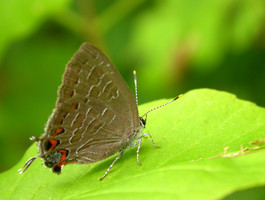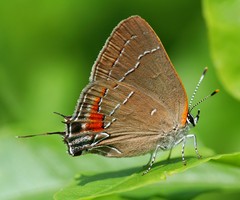Satyrium
Andrew V. Z. Brower- Nearctic Satyrium
- Satyrium acadica
- Satyrium auretorum
- Satyrium behrii
- Satyrium calanus
- Satyrium californica
- Satyrium caryaevorus
- Satyrium edwardsii
- Satyrium favonius
- Satyrium fuliginosa
- Satyrium ilavia
- Satyrium kingi
- Satyrium liparops
- Satyrium polingi
- Satyrium saepium
- Satyrium sylvinus
- Satyrium tetra
- Satyrium titus
- Palaearctic/Oriental Satyrium
- 'Armenia'
- Satyrium hyrcanica
- Satyrium ledereri
- 'Neolycaena'
- Satyrium aeto
- Satyrium baidula
- Satyrium carbonaria
- Satyrium davidi
- Satyrium eckweileri
- Satyrium falkovitshi
- Satyrium iliensis
- Satyrium irkuta
- Satyrium lunara
- Satyrium medea
- Satyrium olga
- Satyrium pretiosa
- Satyrium rhymnus
- Satyrium sajana
- Satyrium sinensis
- Satyrium submontana
- Satyrium tengstroemi
- 'Nordmannia'
- Satyrium abdomnalis
- Satyrium acaciae
- Satyrium eximia
- Satyrium herzi
- Satyrium ilicis
- Satyrium latior
- Satyrium pruni
- Satyrium prunoides
- Satyrium spini
- Satyrium w-album
- 'Superflua'
- Satyrium acaudata
- Satyrium goniopterum
- Satyrium sassanides
- Satyrium lunulata
- Satyrium esculi
- Satyrium grandis
- Satyrium jebelia
- Satyrium iyonis
- Satyrium mackwoodi
- Satyrium oenone
- 'Armenia'
Introduction
A mainly holarctic group of hairstreaks, with some representatives in subtropical Asia. There are a number of names associated with taxa from Taiwan and China which are not listed here because their status cannot be ascertained.
Nomenclature
There are a vast number of generic names associated with Satyrium, in part because of Tutt's publication of numerous homonyms which have spawned replacement names that are now for the most part viewed as synonyms. The circumscription adopted here is that of Robbins (2004). Tuzov et al. (2000) recognize Neolycaena, Nordmannia, Superflua and Armenia as valid genera for temperate Asian forms.
Other Names for Satyrium
- Chrysophanus
- Argus
- Callipsyche
- Neolycaena
- Nordmannia
- Edwardsia
- Klugia
- Kollaria
- Felderia
- Erschoffia
- Fixsenia
- Leechia
- Bakeriia
- Chattendenia
- Strymonidia
- Pseudothecla
- Superflua
- Thecliolia
- Tuttiola
- Necovatia
- Euristrymon
- Harkenclenus
- Rhymnaria
- Armenia
References
Opler, P. A. & Warren, A. D. 2002 Butterflies of North America. 2. Scientific names list for butterfly species of North America, north of Mexico. Contributions of the C. P. Gillette Museum of Arthropod Diversity, 1-79.
Robbins, R. K. 2004. 2004e. Lycaenidae. Theclinae. Tribe Eumaeini, pp. 118-137. In: Lamas, G. (Ed.), Checklist: Part 4A. Hesperioidea - Papilionoidea. In: Heppner, J. B. (Ed.), Atlas of Neotropical Lepidoptera. Volume 5A. Gainesville, Association for Tropical Lepidoptera; Scientific Publishers.
Tuzov, V. K., Bogdanov, P. V., Devyatkin, A. L., Kaabak, L. V., Korolev, V. A., Murzin, V. S., Samodurov, G. D. & Tarasov, E. A. 1997 Guide to the butterflies of Russia and adjacent territories (Lepidoptera, Rhopalocera). Sofia: Pensoft.
Title Illustrations

| Scientific Name | Satyrium liparops |
|---|---|
| Specimen Condition | Live Specimen |
| Source | Hairstreak |
| Source Collection | Flickr |
| Image Use |
 This media file is licensed under the Creative Commons Attribution-NonCommercial License - Version 2.0. This media file is licensed under the Creative Commons Attribution-NonCommercial License - Version 2.0.
|
| Copyright | © 2006 Brad Smith |
| Scientific Name | Satyrium favonius |
|---|---|
| Location | Washington, USA |
| Specimen Condition | Live Specimen |
| Source | http://www.flickr.com/photos/geraldcarter/137729800/ |
| Source Collection | Flickr |
| Image Use |
 This media file is licensed under the Creative Commons Attribution-NonCommercial-NoDerivs License - Version 2.0. This media file is licensed under the Creative Commons Attribution-NonCommercial-NoDerivs License - Version 2.0.
|
| Copyright | © 2006 Gerald Carter |
| Scientific Name | Satyrium ilicis |
|---|---|
| Location | Confluence of Scoltenna and Panaro rivers, Modena Province, Emilia Romagna, Italy |
| Specimen Condition | Live Specimen |
| Image Use |
 This media file is licensed under the Creative Commons Attribution-NonCommercial License - Version 2.0. This media file is licensed under the Creative Commons Attribution-NonCommercial License - Version 2.0.
|
| Copyright |
© 2005 Cesare Brizio

|
About This Page

Middle Tennessee State University, Murfreesboro, Tennessee, USA
Correspondence regarding this page should be directed to Andrew V. Z. Brower at
Page copyright © 2013
 Page: Tree of Life
Satyrium .
Authored by
Andrew V. Z. Brower.
The TEXT of this page is licensed under the
Creative Commons Attribution License - Version 3.0. Note that images and other media
featured on this page are each governed by their own license, and they may or may not be available
for reuse. Click on an image or a media link to access the media data window, which provides the
relevant licensing information. For the general terms and conditions of ToL material reuse and
redistribution, please see the Tree of Life Copyright
Policies.
Page: Tree of Life
Satyrium .
Authored by
Andrew V. Z. Brower.
The TEXT of this page is licensed under the
Creative Commons Attribution License - Version 3.0. Note that images and other media
featured on this page are each governed by their own license, and they may or may not be available
for reuse. Click on an image or a media link to access the media data window, which provides the
relevant licensing information. For the general terms and conditions of ToL material reuse and
redistribution, please see the Tree of Life Copyright
Policies.
- First online 24 March 2008
- Content changed 24 March 2008
Citing this page:
Brower, Andrew V. Z. 2008. Satyrium . Version 24 March 2008 (under construction). http://tolweb.org/Satyrium/112413/2008.03.24 in The Tree of Life Web Project, http://tolweb.org/












 Go to quick links
Go to quick search
Go to navigation for this section of the ToL site
Go to detailed links for the ToL site
Go to quick links
Go to quick search
Go to navigation for this section of the ToL site
Go to detailed links for the ToL site